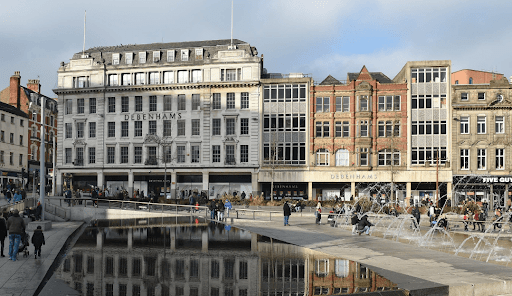As we've been reporting at Civic Revival, the collapse of the Debenhams store chain has posed fundamental questions about the most effective and productive uses to which such often capacious, and now-empty, buildings in 124 UK high streets can be put.
We've already posted about the issues raised when the Group was put into administration before Christmas, and most recently, following the deal for online retailer Boohoo to take on the brand, but not the stores or retail operations.
The Guardian columnist John Harris began a debate on the subject, which has now been joined by his colleague writer Polly Toynbee. She claims that Debenhams' disappearances leaves 'a hole in the heart'.
Department stores are far more than shops, she says. 'They belong to the vanishing public realm: they’re intimate yet convivial places to meet, havens for idle browsing, to use toilets or linger in cafes.' Their closure feels like losing a park, a library, an arts or leisure centre, Toynbee writes. 'A break from shopping in the coffee shop with my mother, nowadays with a daughter, was a rare time to sit and stare at all those other people just like us.' She notes that Arding & Hobbs – pride of Battersea, delight for decades of her life – was later split into a Debenhams, now shut. 'Every town mourns these lost urban sitting rooms,' Toynbee adds. 'Where is Hanningtons of Brighton, Lewis’s of Liverpool, or TP Hughes of Tenby? All are engraved on the landscape of local memory.'
Writers knew their importance, Toynbee argues. 'From Arnold Bennett’s the Old Wives’ Tale to Émile Zola’s Au Bonheur des Dames (adapted for television as The Paradise). From Mr Selfridge to Are You Being Served?, the social ecosystem of these vanishing palaces has been as valuable to script-writers as the Rovers Return or the Queen Vic.' Pubs were vanishing too, a quarter closed this century before the pandemic killed another 6,000 last year, she adds.
'Losing commercial landmarks can matter as much as the public amenities closed or degraded in the wicked 10-year austerity project,' she asserts, adding that 'more than 15,700 shops closed last year, with 176,000 jobs lost. Even charity shops had been crashing: Age UK shut 133 last year. 'You couldn’t invent better symbols of local and national decline than boarded-up shops and pubs in decayed high streets, yet the government has done next to nothing,' Toynbee argues. 'What political folly, when every focus group has people pointing to semi-defunct shopping parades as a sign no one cares about their neighbourhood.'
She points out that the size of the crisis is not always appreciated. 'Prof Joshua Bamfield of the Centre for Retail Research tells me that the operator of the biggest shopping centres hasn’t collected 40% of rents this year,' she reports. 'When the eviction moratorium ends in March, the government needs to intervene to renegotiate rents, which were set back when retail was rich.'
Bamfield points to some thriving department stores such as Jarrolds of Norwich, a success because it’s family-owned and community-rooted, rather than run by property-hungry financiers. “They show how it’s done, with a deli full of local produce, a bookshop and local originality,” he says. But then, he admits, Norwich captures the rich, adds Toynbee.
'Chains now will only stay in wealthy tourist cities, the Yorks and Chesters, or major centres with wide catchments,' she reports as warned by Andrew Carter of Centre for Cities.
Shops will go, but what matters, says Carter, is preserving a critical mass. 'We could redesign empty retail with homes to bring families to live closer to work and that keeps remaining shops alive.' Shopping needed reimagining. Toynbee's answer is that the empty Debenhams could be let out to host pop-ups or any other activities to draw people in. 'The original dazzling 19th-century department store, Paris’s Le Bon Marché, was famed for eye-catching novelties, with “a reading room for husbands” and entertainments for children.'
Business rates relief needed extending until the tax system was reformed 'to take from the Amazon-style online companies and bolster bricks-and-mortar shops'. The government could even take a share in high-street flagships: 'this isn’t picking winners expecting any profit, but a relatively cheap investment for the state, for an excellent return in social value,' Toynbee believes.
Such intervention from the state certainly appears to be unlikely. And, as Toynbee herself almost acknowledges, a failing high street is arguably as much the result of the convenience of online shopping and changing social behaviour patterns, as it is about government neglect.
Nevertheless, the availability of the former Debenhams properties clearly represents an opportunity to actively animate these buildings in a community-oriented way. Toynbee points to the potential for empty Debenhams to host pop ups, or other activities that attract people.
It's not just the Debenhams buildings that are in need of a new future. There's already been the loss of other much-loved and 'traditional' high street staples including Woolworths in 2008, British Home Stores in 2016 and Maplin in 2018 plus many others, and surely yet more to come.
'The pandemic’s good lesson is that governments can do anything if enough people want them to,' says Toynbee. 'If a vaccine can be invented and injected in record time, so too can new life be breathed into dying high streets.' She warns that politicians should note another lockdown lesson: 'how much we all crave human company in social gathering places of every kind.'


